Durst F. Fluid Mechanics: An Introduction to the Theory of Fluid Flows
Подождите немного. Документ загружается.

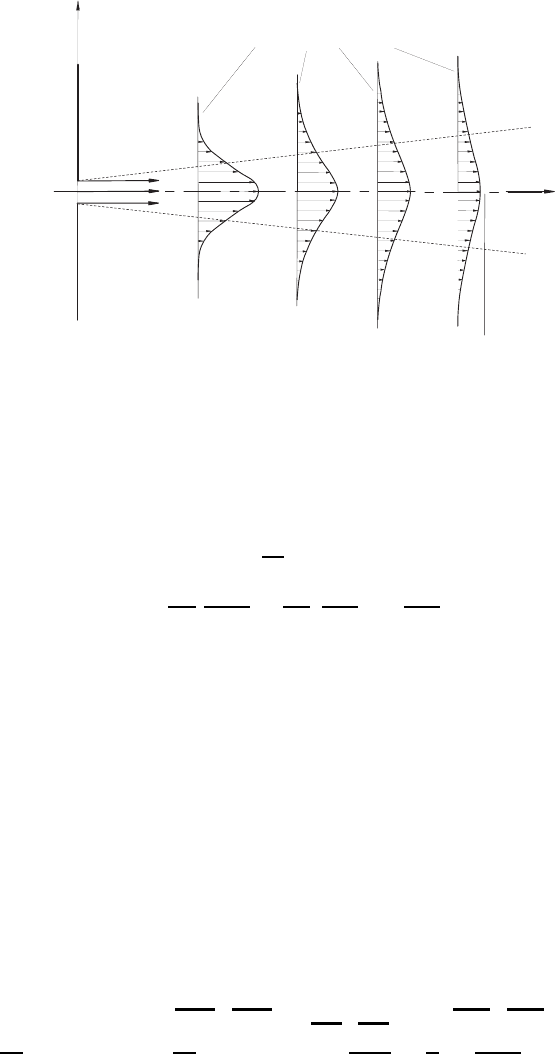
482 16 Flows of Large Reynolds Numbers
( U )
x
A
y
x
Velocity profiles at
different
x
-position
Fig. 16.10 Sketch of the considered plane, two-dimensional laminar free jet
Below a two-dimensional free jet is considered, which can be generated
in the plane x = 0, by a flow from a narrow slit located in the x – y plane.
The jet propagates in the x-direction and the propagation is such, that the
x-axis is the symmetry axis. As the propagation of the jet occurring in the
y-direction is small in comparison with the propagation in the flow direction
and as, moreover, only stationary main flow conditions will be considered,
the boundary-layer equation for
dP
dx
=0canbeemployedtostudytheflow:
∂Ψ
∂y
∂
2
Ψ
∂x∂y
−
∂Ψ
∂x
∂
2
Ψ
∂y
2
= ν
∂
3
Ψ
∂y
3
. (16.81)
This is again the boundary-layer equation for Ψ as it was employed in the
case of the flow along a flat plate and also when the plane shear layer was
considered. The difference from the plate boundary-layer flow occurs due to
the boundary conditions, which for the free jet flow are as follows:
y =0: U
y
=0and(∂U
x
/∂y)=0, as is the symmetry axis,
y = ∞ : U
x
→ 0, as there is no background flow.
(16.82)
For the free jet, the total momentum can be derived as:
I
ges
=
+∞
#
−∞
ρU
2
x
dy =2
+∞
#
0
ρU
2
x
dy =2ρ (U
x
)
2
A
b. (16.83)
The momentum is constant along the x-axis. This follows from (16.68), which
holds for the free jet as given below:
d
dx
+∞
#
0
U
2
x
dy −U
∞
=0
d
dx
+∞
#
0
U
x
dy −
=0
U
∞
δ
dU
∞
dx
=
µ
ρ
=0
+∞
#
0
∂
2
U
x
∂y
2
dy (16.84)
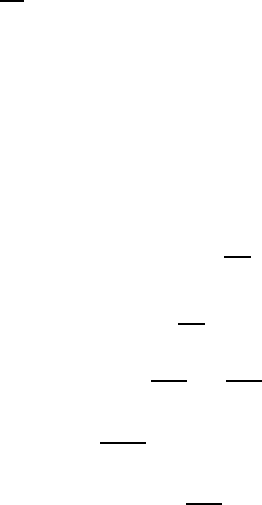
16.6 The Plane, Two-Dimensional, Laminar Free Jet 483
so that one can derive
d
dx
+∞
#
0
U
2
x
dy =0 ; I
ges
=2
+∞
#
0
ρU
2
x
dy = constant. (16.85)
For deriving the similarity solution for the free jet flow, the boundary-layer
equation can be solved with the following ansatzes:
η = x
α
y and Ψ = x
β
f(η). (16.86)
From this the different terms in the boundary layer equation can be expressed
as follows in terms of the introduced quantities η and Ψ:
U
x
=
∂Ψ
∂y
= x
(α+β)
f
, (16.87)
U
y
= −
∂Ψ
∂x
= −x
(β−1)
(αηf
+ βf) , (16.88)
∂U
x
∂y
=
∂
2
Ψ
∂y
2
= x
(2α+β)
f
, (16.89)
∂
2
Ψ
∂x∂y
= x
(α+β−1)
(αηf
+ αf
+ βf
) , (16.90)
∂
3
Ψ
∂y
3
= x
(3α+β)
f
. (16.91)
The boundary-layer equation (16.81) adopts the following form when (16.87)–
(16.91) are inserted into (16.81):
x
(2α+2β− 1)
(α + β) f
2
− βff
= νx
(3α+β)
f
. (16.92)
This equation becomes a physically correct equation for f(η), when the
exponents of the x-terms are equal, hence we can write:
2α +2β − 1=3α + β ; β = α +1. (16.93)
Moreover, one can deduce from the total momentum equation:
I
ges
=2
+∞
#
0
ρU
2
x
dy =2ρx
(α+2β)
+∞
#
0
f
2
dη = constant (16.94)
Hence, we obtain as an additional requirement for α and β:
α +2β = 0 (16.95)

484 16 Flows of Large Reynolds Numbers
so that from (16.93) one can deduce:
α = −
2
3
and β =
1
3
, (16.96)
i.e. the following similarity ansatzes hold:
η = yx
−
2
3
and Ψ = x
1
3
f (η) . (16.97)
By means of these ansatzes the differential equation (16.81) turns into the
following equation to determine f(η):
(f
)
2
+ ff
+3νf
= 0 (16.98)
with the boundary conditions coming from (16.82):
η =0: f =0 and f
=0, (16.99)
η →∞: f
→ 0. (16.100)
Moreover, to eliminate also the factor 3ν from the differential equation (16.98)
in order to obtain a generally valid equation to determine f
(η), the following
ansatzes are finally chosen:
˜η =
1
3ν
1
2
y
x
2
3
and Ψ = ν
1
2
x
1
3
˜
f (˜η). (16.101)
With this one obtains the following ordinary differential equation:
˜
f
2
+
˜
f
˜
f
+
˜
f
= 0 (16.102)
with the following boundary conditions:
y =0:∂U
x
/∂y =0andU
y
=0; ˜η =0:
˜
f
=0and
˜
f =0,
y →∞: U
x
=0 ; ˜η →∞:
˜
f
=0.
(16.103)
On integrating the differential equation (16.102) once, one obtains:
˜
f
˜
f
+
˜
f
= C
1
. (16.104)
The resulting integration constant yields, due to the employed boundary
conditions C
1
=0,asfor˜η =0,
˜
f and also
˜
f
are equal to zero. This
can readily be deduced from the boundary conditions, so that the following
differential equation results:
˜
f
˜
f
+
˜
f
=0. (16.105)
The solution of this differential equation can be obtained through the ansatz:
ξ =
F
#
0
dF
1 − F
2
=
1
2
ln
1+F
1 − F
=tanh
−1
F. (16.106)
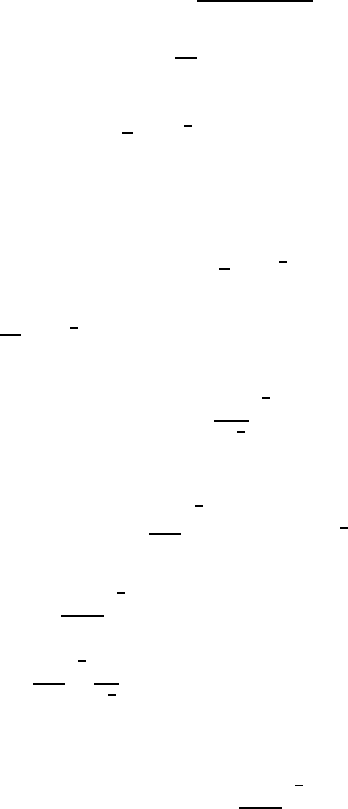
16.6 The Plane, Two-Dimensional, Laminar Free Jet 485
From this it follows that:
F =tanhξ =
1 − exp(−2ξ)
1+exp(−2ξ)
(16.107)
and from (16.104) it follows that
dF
dξ
=1− tanh
2
ξ and thus for U
x
the
following relationship holds:
U
x
=
2
3
A
2
x
−
1
3
!
1 − tanh
2
ξ
"
. (16.108)
The constant A contained in this equation is determined through the
constancy of the total momentum of the free jet:
I
ges
=2
∞
#
0
U
2
x
ρ dy ; I
ges
=
4
3
A
3
ρν
1
2
∞
#
0
!
1 − tanh
2
"
dξ,
I
ges
=
16
9
ρA
3
ν
1
2
(16.109)
or solved for A:
A =0.826
I
ges
ρν
1
2
1
3
. (16.110)
For the velocity components one thus obtains:
U
x
=0.454
*
I
2
ges
ρ
2
ν
+
1
3
!
1 − tanh
2
ξ
"
x
1
3
, (16.111)
U
y
=0.55
I
ges
ν
ρx
2
1
3
7
2ξ
!
1 − tanh
2
ξ
"
− tanh ξ
8
(16.112)
and for ξ =0.275
I
ges
ρν
2
1
3
y
x
2
3
.
The velocity profile that can be computed from the above equations is
shown in Fig. 16.11. The U
y
component of the velocity field is computed at
the edge of the jet:
U
y
(ξ
∞
)=−0.55
I
ges
ν
ρx
2
1
3
.
It is negative and this indicates that the free jet flow continuously sucks in
fluid from the outer flow, so that the mass flow of the free jet increases in the
flow direction.
The mass flow can be computed at each point x of the free jet:
˙m = ρ
+∞
#
−∞
U
x
dy, (16.113)
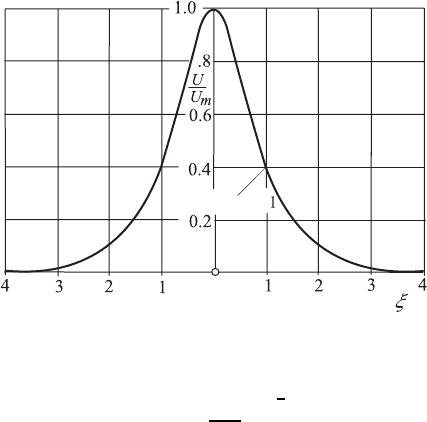
486 16 Flows of Large Reynolds Numbers
Velocity profile
for 2-dim . jet
−−−−
Fig. 16.11 Velocity profile of the plane free jet flow
˙m =3.3
I
ges
ρ
νx
1
3
. (16.114)
The fluid input into the free jet flow takes place due to the viscosity of the
fluid, i.e. the entrainment is caused by the molecular momentum transport.
16.7 Plane, Two-Dimensional Wake Flow
Additional flows that are important in practice and that can be treated with
the aid of the boundary-layer equations, are wake flows showing the features
sketched in Fig. 16.11. This figure shows a plane, two-dimensional wake flow
as occurs, e.g., behind a plane plate or a cylinder located with the main axis
perpendicular to the x–y plane. Such flows are characterized by a momentum
deficit, which corresponds in its integral properties to the flow resistance force
of the plate or cylinder around which a flow passes. This can be computed
by employing the integral form of the momentum equation:
K
w
=2ρB
∞
#
0
U
1
(U
∞
− U
1
)dy, (16.115)
where U
1
(y) represents the velocity profile of the wake flow existing at a
certain x-position, B is the width of the plate in z-direction, and U
∞
corre-
sponds to the main flow in the x-direction at y →∞. For the infinitely thin
plane plate, one obtains the result
K
w
=2ρBU
2
∞
δ
2
. (16.116)
For the cylinder one obtains
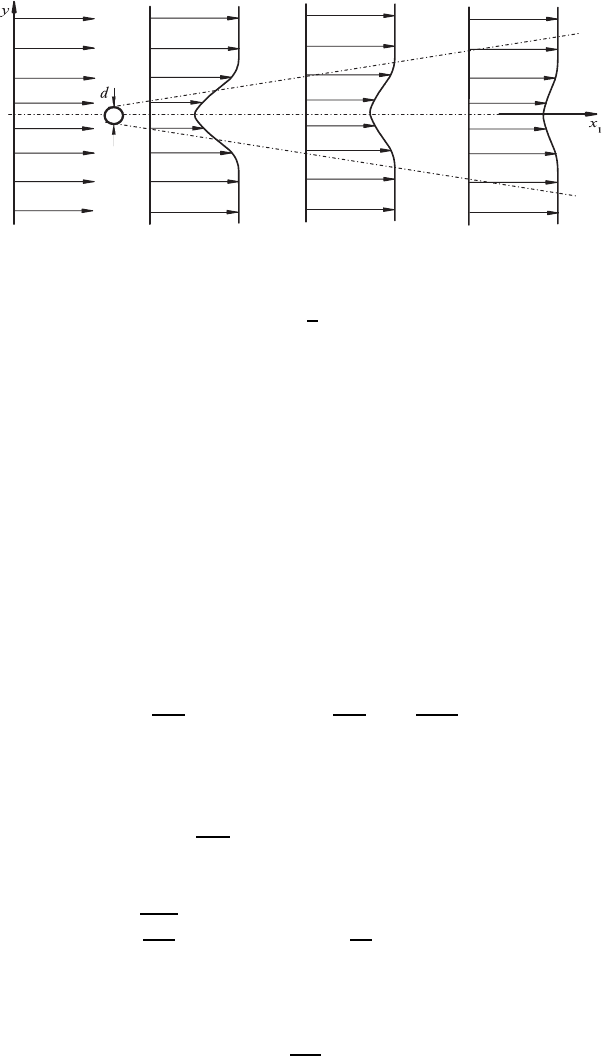
16.7 Plane, Two-Dimensional Wake Flow 487
Fig. 16.12 Wake flow behind a body around which a flow takes place
K
w
= c
w
ρ
2
U
2
∞
!d. (16.117)
Although the actual flow structure near the plate or cylinder around which
the flow passes can be complicated, the flow in the downward field proves to be
of the kind that becomes independent of the body which generated the wake
flow. In the downstream region, the flow has a boundary-layer flow structure,
as the fluid flow in the x-direction of the wake takes place convectively and
the transverse distribution is established by diffusion.
For the treatment of the wake flow, sketched in Fig. 16.12, the velocity
difference can be expressed as
u(x
1
,x
2
)=U
∞
− U
1
(x
1
,x
2
) (16.118)
and it is this difference that is introduced into the boundary-layer equations.
When considering that the pressure in the entire flow region is constant and
that moreover, because u(x
1
,x
2
) << U
∞
holds, one can write
(U
∞
− u)
∂
∂x
1
(U
∞
− u) ≈ U
∞
∂u
∂x
1
= ν
∂
2
u
∂x
2
2
(16.119)
and, hence, one obtains the differential equation that is to be solved for the
wake flow. The boundary conditions can be stated as
x
2
=0:
∂u
∂x
2
=0 and x
2
→∞: u =0. (16.120)
Similarly to the earlier ansatzes, the following relationships are introduced.
η = x
2
0
U
∞
νx
1
and u = U
∞
C
x
1
!
−1/2
f (η) (16.121)
and (16.121) introduced into (16.115) yields
K
w
= ρBU
2
∞
C
ν!
U
∞
1/2
+∞
#
−∞
f(η)dη. (16.122)
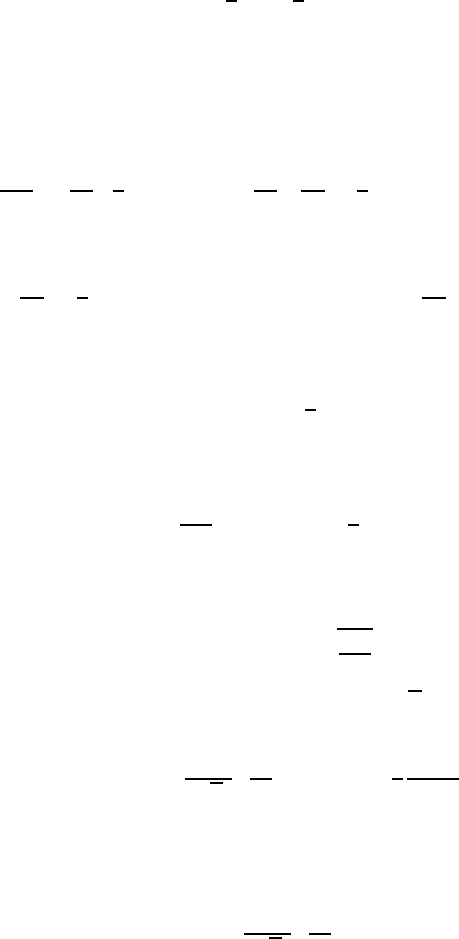
488 16 Flows of Large Reynolds Numbers
On introducing (16.121) into (16.119), one obtains the ordinary differential
equation to be solved for wake flows:
f
+
1
2
ηf
+
1
2
f = 0 (16.123)
with the boundary conditions:
η =0:f
(η)=0 and η →∞: f (η) → 0. (16.124)
Equation (16.123) can be rewritten and integrated:
d
2
f
dη
2
+
d
dη
1
2
ηf
=0,
d
dη
df
dη
+
1
2
ηf
= 0 (16.125)
so that following final relationship holds:
df
dη
+
1
2
ηf = C ; C =0, since η =0
df
dη
=0. (16.126)
In this way, the solution for f(η) is obtained as an exponential function of
η
2
:
f(η)=exp
−
1
4
η
2
. (16.127)
With this, the following can be computed from (16.122):
K
w
= ρBU
2
∞
C
ν!
U
∞
1/2
+∞
#
−∞
exp
−
1
4
η
2
dη. (16.128)
For the flat plate the value of K
w
can be computed by integration along both
plate sides:
K
w
=1.328BρU
2
∞
0
ν!
U
∞
(16.129)
so that for C in (16.128) one can deduce C =0.664/
√
π. Hence, one obtains
for the velocity profile of the wake flow behind a flat plate:
U
1
(x
1
,x
2
)=U
∞
− U
∞
0.664
√
π
x
1
!
−1/2
exp
−
1
4
x
2
2
U
∞
x
1
ν
. (16.130)
This somewhat asymptotic solution is given in Fig. 16.13, namely for the
difference velocity u(x
1
,x
2
) ; U(η), normalized with the local maximum of
the “deficit velocity”:
U
max
= U
∞
0.664
√
π
x
1
!
−1/2
, (16.131)
i.e. U(η)/U
max
is plotted in Fig. 16.13.
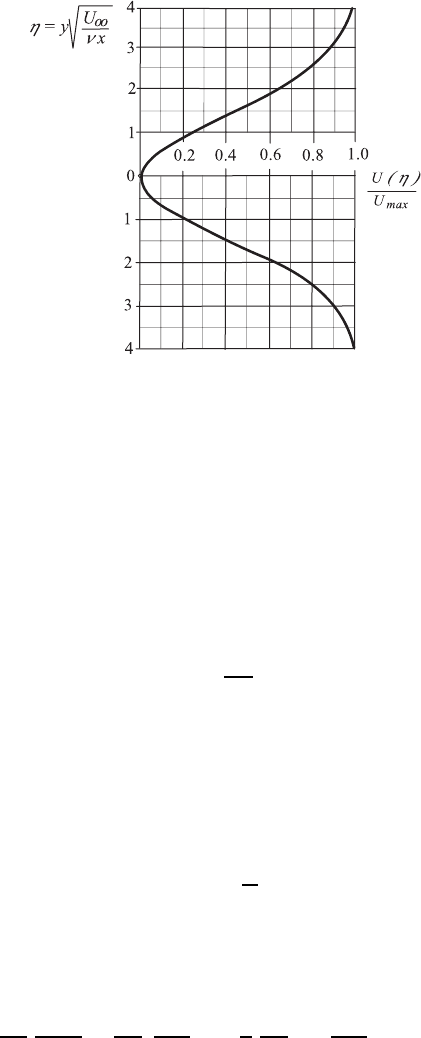
16.8 Converging Channel Flow 489
−
−
−
−
−
Fig. 16.13 Solution for the normalized wake flow behind a plate
16.8 Converging Channel Flow
The boundary-layer flows considered above, were all characterized by an outer
flow with constant velocity. They thus represent the easiest flows which can
be solved with aid of the boundary-layer equations.
Based on the solution procedure derived by Blasius, in this section the
boundary layer of a flow will be considered, whose imposed flow is given by
the following velocity distribution:
U
∞
(x)=−
U
Q
x
= U(x), (16.132)
where U
Q
=
˙
Q/x, i.e. is the velocity existing at x = 1. When considering that
the velocity distribution corresponds to that of a sink flow in a convergent
channel with an aperture angle α between the plane walls, then the volume
flow rate flowing through the region α
˙
Q = αxhU
Q
is given for h =1by
αU
Q
, i.e. the following holds:
U
Q
=
˙
Q
α
. (16.133)
Because of the above-suggested velocity distribution of the flow, outside the
developing boundary layers, a pressure gradient results in the stationary
boundary-layer equation:
∂Ψ
∂y
∂
2
Ψ
∂x∂y
−
∂Ψ
∂x
∂
2
Ψ
∂y
2
= −
1
ρ
dP
dx
+ ν
∂
3
Ψ
∂y
3
. (16.134)
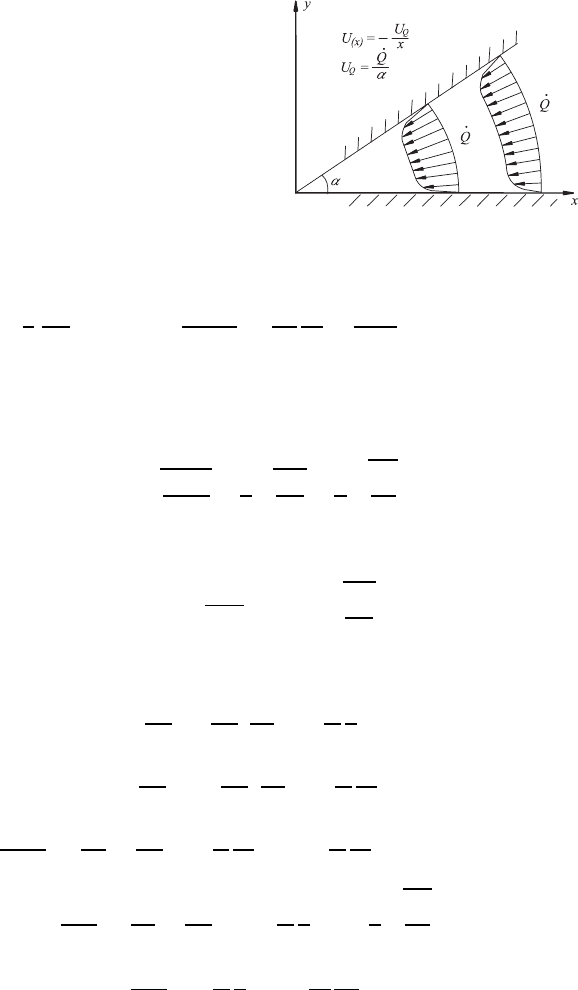
490 16 Flows of Large Reynolds Numbers
Fig. 16.14 Diagram to explain boundary-
layer formation in a converging two-
dimensional channel flow
The resulting pressure gradient can be computed as:
1
ρ
dP
dx
= −U
∞
(x)
dU(x)
dx
=
˙
Q
αx
˙
Q
α
2
=
˙
Q
2
α
2
x
3
. (16.135)
In order to obtain the sought similarity solution for the boundary layer
which forms at the walls of a converging channel flow (Fig. 16.14), the
following similarity variable is introduced:
η = y
0
−U
∞
xν
=
y
x
0
U
Q
ν
=
y
x
$
˙
Q
αν
. (16.136)
For the stream function of the flow we introduce
Ψ(x, y)=−
νU
Q
f(η)=−
$
˙
Qν
α
f(η) (16.137)
so that for the different terms in (16.38) the following relationships can be
derived:
U
x
=
∂Ψ
∂y
=
∂Ψ
∂η
∂η
∂y
= −
˙
Q
α
1
x
f
(η), (16.138)
U
y
= −
∂Ψ
∂x
= −
∂Ψ
∂η
∂η
∂x
= −
˙
Q
α
y
x
2
f
(η), (16.139)
∂
2
Ψ
∂x∂y
=
∂
∂x
∂Ψ
∂y
=
˙
Q
α
1
x
2
f
(η)+
˙
Q
α
η
x
2
f
(η), (16.140)
∂
2
Ψ
∂y
2
=
∂
∂y
∂Ψ
∂y
= −
˙
Q
α
1
x
f
(η)
1
x
$
˙
Q
αν
, (16.141)
∂
3
Ψ
∂y
3
= −
˙
Q
α
1
x
f
(η)
1
x
2
˙
Q
αν
. (16.142)
On inserting (16.134) and also (16.136)–(16.140) in the boundary-layer equa-
tion (16.132), one obtains the following differential equation for f (η); only

16.8 Converging Channel Flow 491
a few terms remain, since the products of the mixed derivatives f
f
cancel
out:
f
− (f
)
2
+ 1 = 0 (16.143)
with the boundary conditions at η =0,f
= 0 and for η →∞,f
=1and
f
=0.
The integration of the above differential equation becomes analytically
possible with the ansatz
F (η)=f
(η) (16.144)
so that (16.143) can be written as
F
= F
2
− 1 with F (0) = 0 and F (∞)=1. (16.145)
On multiplying both sides with the first derivative F
(η), it is possible, by
partial integration, to obtain the following solution:
(F
)
2
−
2
3
(F − 1)
2
(F +2)=C, (16.146)
where C is the integration constant, which, because F → 1andF
→ 0as
η →∞, adopts the value C = 0. Hence, from (16.146) it follows that
F
=
dF
dη
=
0
2
3
(F − 1)
2
(F + 2) (16.147)
or rewritten:
dη =
dF
2
3
(F − 1)
2
(F +2)
. (16.148)
Hence, the following equation holds:
η =
F
#
0
dF
2
3
(F − 1) (F +2)
. (16.149)
The integral can be given in a closed form:
η =
0
3
2
*
tanh
−1
√
2+F
√
3
− tanh
−1
0
2
3
+
. (16.150)
Solved in terms of F =
U
x
U
= f
(η):
f
(η)=
U
x
U
=3tanh
2
η
√
2
+ln
√
3+
√
2
− 2 (16.151)
